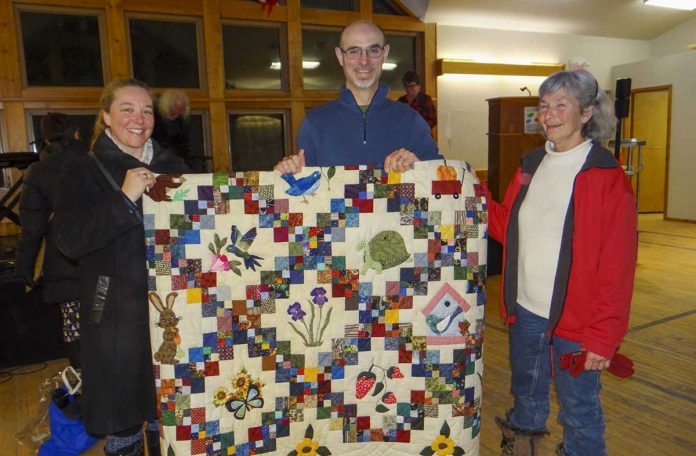MANITOWANING – Six o’clock came before the light of dawn on Friday, December 13, along with the news that Manitoulin Streams Improvement Association had been dreading to hear—school buses had been cancelled on Manitoulin Island.
The massive snow storm from the previous day had continued into the night and left many Island roads in rough condition. In a rural district such as Manitoulin, cancelled buses are the equivalent of a full snow day because of the high numbers of bus-dependent students.
It was unfortunate timing. At 10 that morning, school groups were scheduled to arrive at the Assiginack Arena in Manitowaning to help out Manitoulin Island’s waterway and wetland conservation group with its annual eyed egg event.
At that rate, it might have just been the hardy volunteers of Manitoulin Streams who would have had to take on the massive task of stocking as many as 10,000 brook trout eggs in specially designed Scotty boxes, and then place them in the flowing waters of Norton’s Creek to grow.
The scramble to save the event was on. Last-minute messages were posted on the social media accounts of Assiginack Public School and the Township of Assiginack, while the organizers got ready for what might have been a long, tedious day.
By what might otherwise be described as a Christmas miracle (albeit one that landed a week and a half early), as the start time neared, cars began to arrive at the parking lot of the arena. Others wandered in from the streets in Manitowaning. Soon, as many as 50 people were in the arena hall.
The brook trout eggs would indeed find their way into Island waters that day. The event was saved.
“Thank you for showing up,” said retired Ontario Ministry of Natural Resources and Forestry (MNRF) biologist Bob Florean. “I was expecting maybe a half a dozen people; I’m really impressed to see everybody that’s here.”
Mr. Florean has attended the annual brook trout eyed egg event for years to offer his expertise and insights to the process. It’s an event he helped to shape with Manitoulin Streams project co-ordinator Seija Deschenes.
This was the first year the event has been held at the Assiginack Arena. Previously, it took place at the late Bob Hutton’s garage on Bidwell Road near the release site at Norton’s Creek.
“Having it at the community centre had some real advantages. We had no cold fingers, more community members came out, and the space is warm, accessible and we have great food,” said Ms. Deschenes.
This event took place relatively late this year. It normally happens at the beginning of December but Ms. Deschenes said she could only get the Nipigon-strain brook trout eggs at the later date this year.
The ones that did arrive, however, tended to be smaller than normal and likely came from less robust, mature fish this year. The changing climate might have contributed to this, including the summer heatwave that led to fish die-offs on Manitoulin’s inland lakes.
Norton’s Creek was raised as a problem area in 2003, when Mr. Florean and conservationists began the restoration work to return the creek to its former health.
The waterway once hosted a native brook trout population which had long since disappeared, so stocking these fish was the next step to restoring the stream’s health.
“The Nipigon strain is about as close as you can get to the wild brook trout that were here,” said Mr. Florean.
The volunteers carefully took the eggs and placed one into each cell of plastic contraptions known as Scotty boxes, rectangular stackable components that hold hundreds of eggs when assembled in a set. The name comes from their designer, the Scotty marine plastics company that makes fishing gear and boating supplies.
Having young students participate in this event is an important way to teach them about natural processes and life cycles, as well as the amount of work it takes to restore habitats and their constituent species that together make up ecosystems. This provides a powerful, hands-on lesson in the value of conservation and respecting the planet.
Volunteer Jim Bryant said those teachings are invaluable, especially when reflecting on his own childhood. Poaching more than one’s limit of fish was a common practice among him and his friends, because they did not fully understand the impacts of that behaviour.
Eight-year-old Hope Flikweert said she particularly enjoyed putting the eggs in their compartments.
“It’s really cool; I never get to do anything like this,” she said.
Volunteer Bethany Gulyas agreed that the event offered her more tangible takeaways than more traditional learning from textbooks.
“You can read all about it, but to actually do it is a whole other thing,” she said.
Amanda Gulyas said she thought it was neat to feel the fish move inside the eggs and Matthew Gulyas said he was a fan of all things wildlife, so the event spoke to those interests. He responded with a resounding ‘yes’ when asked whether he’d be out on the water someday trying to catch these fish after they had grown up.
Ms. Deschenes said environmental testing done on the Norton’s Creek site by Collège Boréal have shown brook trout existing throughout the length of the waterway, indicating a healthy waterway that can comfortably accommodate native fish populations.
This initiative has seen more than 80,000 brook trout eggs stocked in Norton’s Creek since it began a decade ago in 2009.





